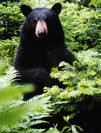Day 4: St. George Dinosaur Tracks, UT
One of the great things about touring the American southwest is the myriad dinosaur related side trips. They range from magnificent places like the remote moutainside boneyard at Vernal, Utah to the small but impressive display at the Museum of Northern Arizona in Flagstaff. I've seen dinosaur tracks for free on the Navajo reservation and on vertical red sandstone cliffs. For abundance and variety of unique specimens, however, it's hard to top the St. George Dinosaur Discovery Site.
 You won't find any life size reproductions or assembled dino skeletons here. Young children may see it as just a bunch of mud colored rocks, but for the older dinosaur buff and scientifically curious, there are rare treasures on display in this warehouse-like building. Discovered only eight years ago, the site has already made a large impact on paleontology. There are a few dead bones to be found, but most of what's been left behind are hints of how Jurassic creatures lived and moved.
You won't find any life size reproductions or assembled dino skeletons here. Young children may see it as just a bunch of mud colored rocks, but for the older dinosaur buff and scientifically curious, there are rare treasures on display in this warehouse-like building. Discovered only eight years ago, the site has already made a large impact on paleontology. There are a few dead bones to be found, but most of what's been left behind are hints of how Jurassic creatures lived and moved.
One of the great things about touring the American southwest is the myriad dinosaur related side trips. They range from magnificent places like the remote moutainside boneyard at Vernal, Utah to the small but impressive display at the Museum of Northern Arizona in Flagstaff. I've seen dinosaur tracks for free on the Navajo reservation and on vertical red sandstone cliffs. For abundance and variety of unique specimens, however, it's hard to top the St. George Dinosaur Discovery Site.
 You won't find any life size reproductions or assembled dino skeletons here. Young children may see it as just a bunch of mud colored rocks, but for the older dinosaur buff and scientifically curious, there are rare treasures on display in this warehouse-like building. Discovered only eight years ago, the site has already made a large impact on paleontology. There are a few dead bones to be found, but most of what's been left behind are hints of how Jurassic creatures lived and moved.
You won't find any life size reproductions or assembled dino skeletons here. Young children may see it as just a bunch of mud colored rocks, but for the older dinosaur buff and scientifically curious, there are rare treasures on display in this warehouse-like building. Discovered only eight years ago, the site has already made a large impact on paleontology. There are a few dead bones to be found, but most of what's been left behind are hints of how Jurassic creatures lived and moved. The most obvious displays are the dinosaur footprints, dozens upon dozens of them, some single, some in trackways. The largest ones were made by dilophosaurs, but there are a number of smaller ones made by some as yet unidentified animals. These were the megafauna of their time. Even more interesting are the smaller bits scattered here and there: insect trails, turtle rubs, mollusc shells, plant root castings, burrows, fish fossils, seeds, plant impressions, the list goes on. The truly rare and bizarre are the fish and dinosaur swim tracks, tail drags, skin impressions, even a depression left by a sitting dinosaur. It is a sandstone text book offering a view of an entire ancient ecosystem and the interdependece of the organisms in it. It is a prehistoric Rosetta stone, waiting for us to solve a thousand riddles of evolution. Fascinating and captivating.
The most obvious displays are the dinosaur footprints, dozens upon dozens of them, some single, some in trackways. The largest ones were made by dilophosaurs, but there are a number of smaller ones made by some as yet unidentified animals. These were the megafauna of their time. Even more interesting are the smaller bits scattered here and there: insect trails, turtle rubs, mollusc shells, plant root castings, burrows, fish fossils, seeds, plant impressions, the list goes on. The truly rare and bizarre are the fish and dinosaur swim tracks, tail drags, skin impressions, even a depression left by a sitting dinosaur. It is a sandstone text book offering a view of an entire ancient ecosystem and the interdependece of the organisms in it. It is a prehistoric Rosetta stone, waiting for us to solve a thousand riddles of evolution. Fascinating and captivating.This is an active research site, with new discoveries being made all the time. (As evidence of this, check out the huge pile of rocks out back.) Some finds haven't even been properly classified yet. There aren't any prettied up displays or fancy fonts. You tread across concrete and sandstone, separated from the Do-Not-Touch pieces by nothing more than a rope. That's why I like it. It's a peek inside an active and engrossing disipline, and if you squint real hard, you just might see that dinosaur swimming toward you, breathing and alive.
Teasers on this trip: canyons, wildlife, Weeping Rock, Shakespeare

1 comment:
Oh man....
I want to GO!
Thanks for turning us on to something better than the neighborhood.
Post a Comment